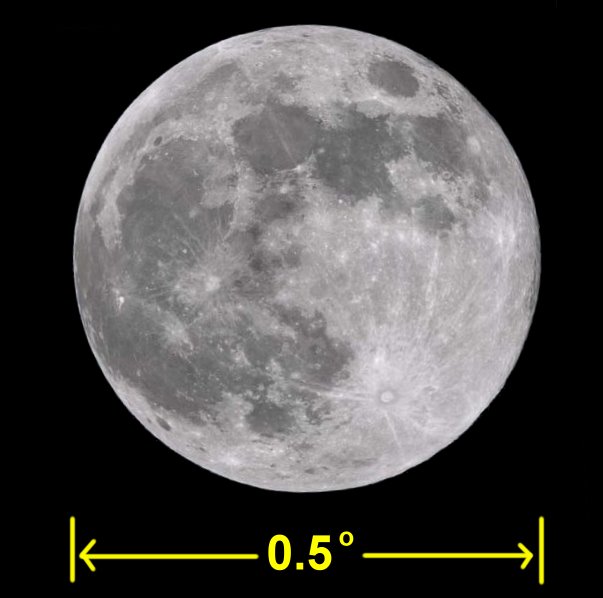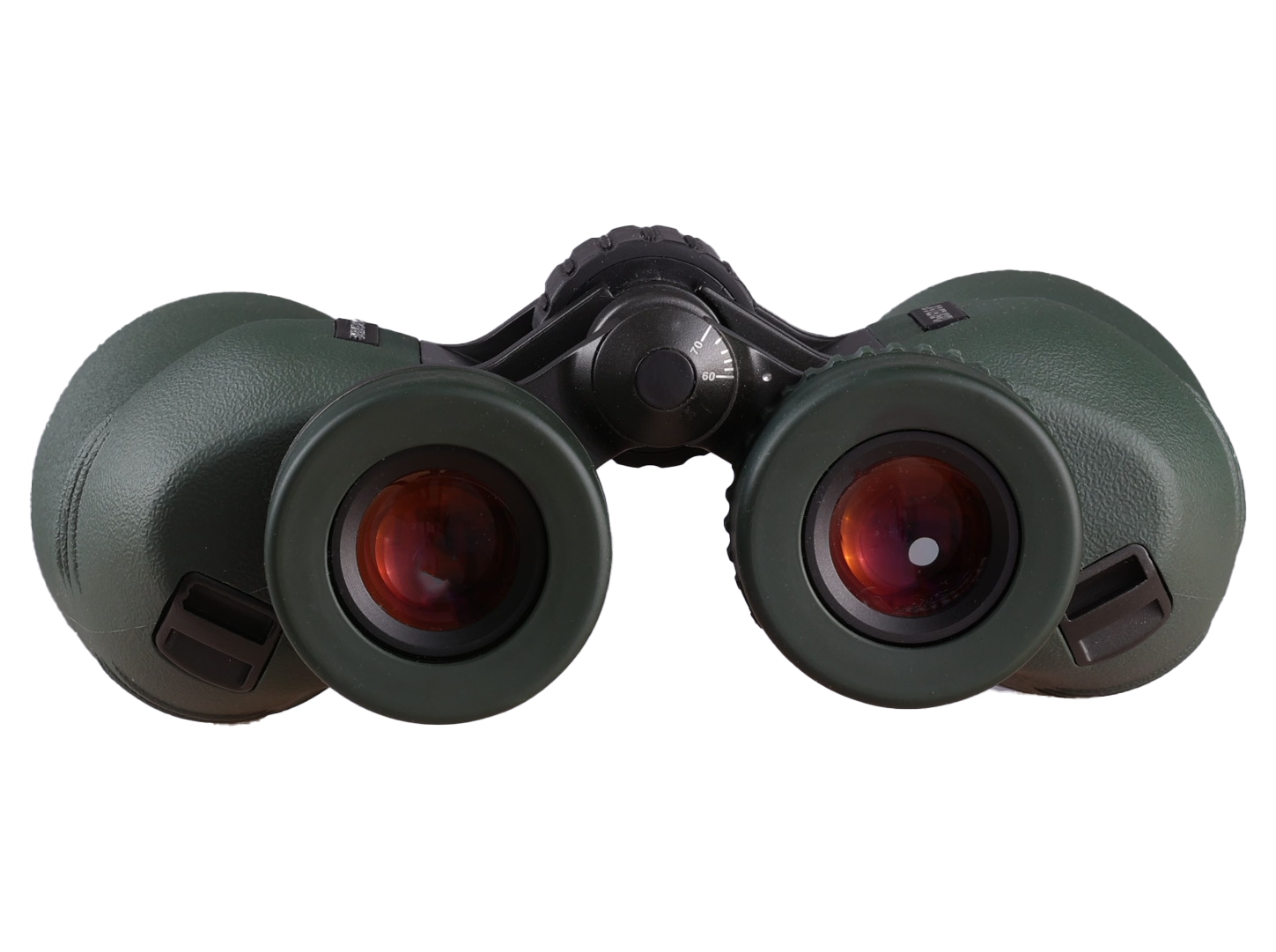Understanding Degrees, Arc Minutes, and Arc Seconds
 When measuring binocular views, the unit of measurement we use is degrees (think 360 degrees in a circle), and is designated by °. For example, a 10×50 binocular typically has a 6.5° field of view, and the earth’s Moon is about 0.5° in diameter—so the Moon would be 1/13th the width (and height) of the view through that binocular. To obtain a finer unit of measurement, we can divide a degree by 60, which is an “arc minute” (designated by ‘). So we can also say the Moon is 30’ in diameter (it’s actually 31’). We can divide an arc minute by 60 to obtain an even finer unit of measurement—the “arc second” (designated by “).
When measuring binocular views, the unit of measurement we use is degrees (think 360 degrees in a circle), and is designated by °. For example, a 10×50 binocular typically has a 6.5° field of view, and the earth’s Moon is about 0.5° in diameter—so the Moon would be 1/13th the width (and height) of the view through that binocular. To obtain a finer unit of measurement, we can divide a degree by 60, which is an “arc minute” (designated by ‘). So we can also say the Moon is 30’ in diameter (it’s actually 31’). We can divide an arc minute by 60 to obtain an even finer unit of measurement—the “arc second” (designated by “).



 The US Navy standard for Opticalman (OM) personnel (disestablished in 1999) was to strive for binocular alignment of 2’ (or 120”) of “step” (vertical alignment), 2’ of horizontal divergence (separation), and 4’ (or 240”) of horizontal convergence (cross-over). This was considered quite stringent by military standards, but keep in mind that most military binoculars serviced by Opticalmen were operating at relatively-low magnifications—typically 10x or less. Even the largest battleship binoculars were limited to 20x. The OM standard is still the reference standard for most brands today. Oberwerk has a Navy Mk 5 collimator, as used by Navy Opticalmen, but that collimator can’t be used for tail-of-arc 3-axis alignment with 45-degree-view binocular telescopes, where precise alignment is especially critical. Because Oberwerk is the world’s leading supplier of ultra-high magnification binoculars, operating from 40x to 96x magnification (and tested at up to 168x), our standards for optical alignment are much more demanding. As you will see, we apply that same high standard for precise alignment to all of our binoculars.
The US Navy standard for Opticalman (OM) personnel (disestablished in 1999) was to strive for binocular alignment of 2’ (or 120”) of “step” (vertical alignment), 2’ of horizontal divergence (separation), and 4’ (or 240”) of horizontal convergence (cross-over). This was considered quite stringent by military standards, but keep in mind that most military binoculars serviced by Opticalmen were operating at relatively-low magnifications—typically 10x or less. Even the largest battleship binoculars were limited to 20x. The OM standard is still the reference standard for most brands today. Oberwerk has a Navy Mk 5 collimator, as used by Navy Opticalmen, but that collimator can’t be used for tail-of-arc 3-axis alignment with 45-degree-view binocular telescopes, where precise alignment is especially critical. Because Oberwerk is the world’s leading supplier of ultra-high magnification binoculars, operating from 40x to 96x magnification (and tested at up to 168x), our standards for optical alignment are much more demanding. As you will see, we apply that same high standard for precise alignment to all of our binoculars. From our building’s setup/test area, we have an ideal collimation target—the WKEF television antenna tower, 3.5 miles away. The tower is a remarkable structure—it’s 1150 feet tall, with a “candelabra” near the top, supporting three antenna masts. This structure gives us multiple vertical and horizontal lines to use as a reference when aligning binoculars. At 3.5 miles, one arc second of degree (1/3600 of a degree) roughly equals one inch on the tower. Even at 168x, one inch is not discernible at that distance, but with our XL Series binocular telescopes, using 4mm eyepieces, we can see differences in step (vertical alignment), as well as convergence/divergence (horizontal alignment) as small as 6 inches (6 arc seconds). So <6” is our standard for our highest-magnification binoculars. The standard relaxes relative to a binocular model’s magnification, as you can see in the table below. But we’re confident that our standards for precise optical alignment are unmatched in the industry. Shockingly, a competitor charges extra (a lot extra!) for their most-precise alignment. Oberwerk only ships binoculars that are as precisely aligned as possible—at no extra charge.
From our building’s setup/test area, we have an ideal collimation target—the WKEF television antenna tower, 3.5 miles away. The tower is a remarkable structure—it’s 1150 feet tall, with a “candelabra” near the top, supporting three antenna masts. This structure gives us multiple vertical and horizontal lines to use as a reference when aligning binoculars. At 3.5 miles, one arc second of degree (1/3600 of a degree) roughly equals one inch on the tower. Even at 168x, one inch is not discernible at that distance, but with our XL Series binocular telescopes, using 4mm eyepieces, we can see differences in step (vertical alignment), as well as convergence/divergence (horizontal alignment) as small as 6 inches (6 arc seconds). So <6” is our standard for our highest-magnification binoculars. The standard relaxes relative to a binocular model’s magnification, as you can see in the table below. But we’re confident that our standards for precise optical alignment are unmatched in the industry. Shockingly, a competitor charges extra (a lot extra!) for their most-precise alignment. Oberwerk only ships binoculars that are as precisely aligned as possible—at no extra charge.
